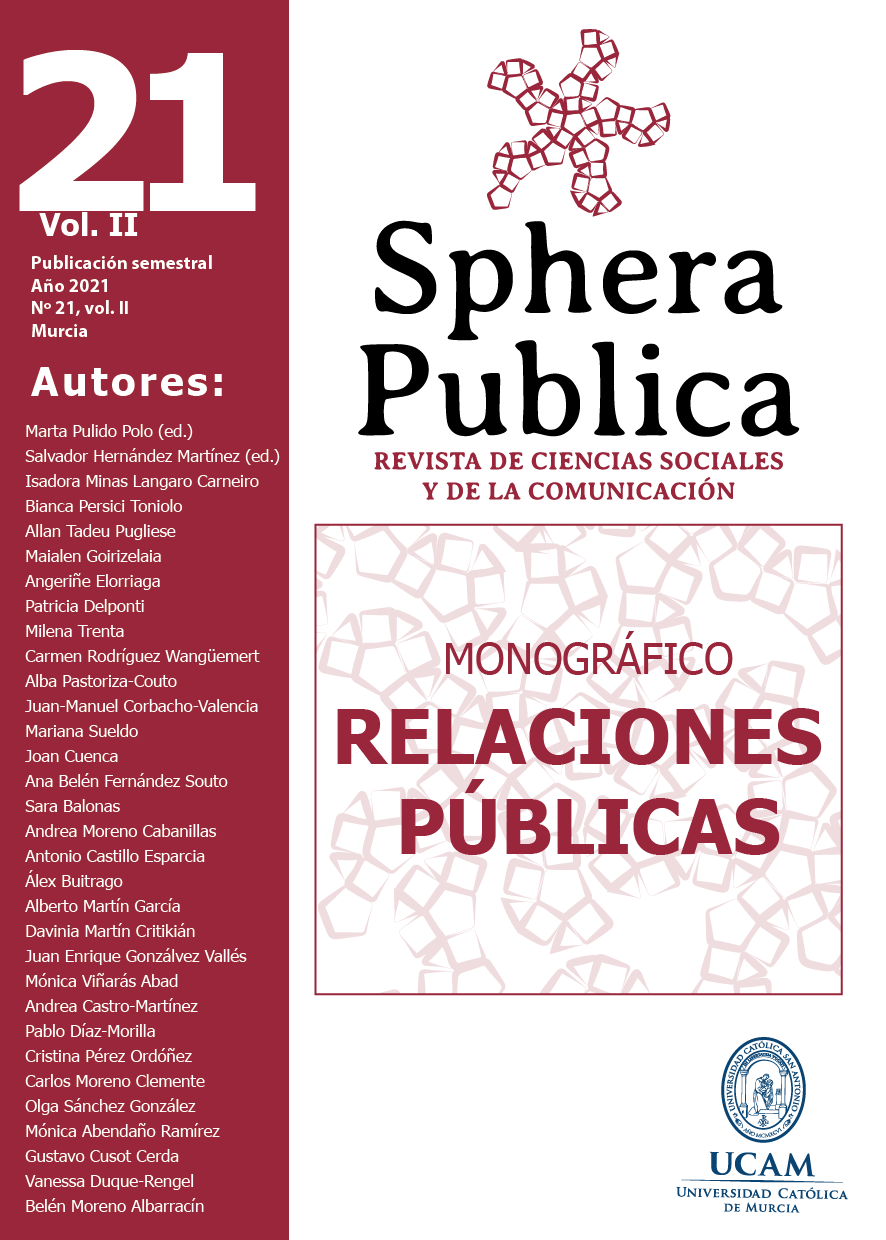La felicidad y el bienestar en las organizaciones y su relación con la marca ciudad y la marca territorio. El caso de Great Place to Work Málaga
Keywords:
Relaciones públicas, felicidad corporativa, marca territorio, marca ciudad, felicidad laboral, comunicación estratégicaAbstract
La felicidad laboral es un asunto de creciente interés que como ventaja competitiva se vincula a la cultura corporativa y a las relaciones públicas internas. Este trabajo se centra en el estudio de caso de la iniciativa Great Place to Work Málaga, con el objetivo de analizar el proyecto y el modo en que puede contribuir a la marca territorio. Para ello se ha empleado revisión documental de numeroso material corporativo, informes internos, documentación para prensa y apariciones en medios, así como una entrevista en profundidad al responsable del proyecto. Los resultados indican que se trata de una iniciativa que ha logrado el respaldo de las administraciones públicas al constituir una oportunidad de mejora del posicionamiento de la provincia como foco de atracción de talento e inversiones y que contribuye de forma positiva a la construcción de la marca de la ciudad. Así, el fomento de la felicidad y el bienestar organizacional no sólo resulta beneficioso a nivel individual para las organizaciones que lo potencian, sino que se trata de una estrategia de relaciones públicas a nivel interno y externo que repercute de forma positiva en el conjunto del tejido empresarial, potenciando la marca territorio.
References
Boisen, M., Terlouw, K., Groote, P., y Couwenberg, O. (2018). Reframing place promotion, place marketing, and place branding-moving beyond conceptual confusion. Cities, 80, 4-11. https://doi.org/10.1016/j.cities.2017.08.021
Briones- Jácome, I. E. (2020). Psicología organizacional en tiempos de la pandemia COVID-19. Dominio de las Ciencias, 6(3), 26-34. https://dialnet.unirioja.es/servlet/articulo?codigo=7539705
Cardwell, L. A., Williams, S., y Pyle, A. (2017). Corporate public relations dynamics: Internal vs. external stakeholders and the role of the practitioner. Public Relations Review, 43(1), 152-162. https://doi.org/10.1016/j.pubrev.2016.11.004
Castro-Higueras, A. y Pérez-Rufí, J.P. (2021). Cultura, tecnología y urbanismo: las bases para construir una ciudad global. El caso Málaga. Revista Mediterránea de Comunicación, 12(1), 65-76. https://www.doi.org/10.14198/MEDCOM000022
Castro-Martínez, A. y Díaz-Morilla, P. (2019). Análisis del ranking Great Place to Work y de los premios del Observatorio de Comunicación Interna: prácticas de comunicación interna en empresas españolas (2014-2018). El profesional de la información,28(5), e280518. https://doi.org/10.3145/epi.2019.sep.18
Castro-Martínez, A., y Díaz-Morilla, P. (2020). Comunicación interna y gestión de bienestar y felicidad en la empresa española. Profesional De La Información, 29(3). https://doi.org/10.3145/epi.2020.may.24
Chong, M. (2007). The role of internal communication and training in infusing corporate values and delivering brand promise: Singapore Airlines' experience. Corporate Reputation Review, 10(3), 201-212. https://doi.org/10.1057/palgrave.crr.1550051
Comisión Europea (2020). Report on the quality of life in european cities, 2020. European Commission. https://ec.europa.eu/regional_policy/sources/docgener/work/qol2020/quality_life_european_cities_en.pdf
Cruz, E. D. R., Ruiz, E. M., y Zamarreño, G. (2017). Marca territorio y marca ciudad, utilidad en el ámbito del turismo. El caso de Málaga. International journal of scientific management and tourism, 3(2), 155-174. https://dialnet.unirioja.es/servlet/articulo?codigo=6132936
de Waal, A. (2018). Increasing organisational attractiveness: The role of the HPO and happiness at work frameworks. Journal of Organizational Effectiveness: People and Performance, 5(2),124-141. https://doi.org/10.1108/JOEPP-10-2017-0080
Díaz Pincheira, F. J., y Carrasco Garcés, M. E. (2018). Effects of organizational climate and psychosocial risks on happiness at work. Contaduría y administración, 63(4), 0-0.
dos Santos, J.R. y Pedro, L. (2020) Reinventing Human Resource Management to Increase Organizational Efficacy. In: Machado C., Davim J. (eds) Entrepreneurship and Organizational Innovation. Management and Industrial Engineering. Springer, Cham. https://doi.org/10.1007/978-3-030-19289-1_2
Durand, J. P. (2000). Combien y at-il de souffrance au travail?. Sociologie du travail, 42(2), 313-322.
Echeverri, L. M. (2018). Marketing Territorial y su relación con Marca País. Marketing, 3. https://paismarca.com/2013/07/30/marketing-territorial/
Edwards, L. (2018). Understanding public relations: Theory, culture and society. Sage.
Fisher, C. D. (2010). Happiness at work. International journal of management reviews, 12(4), 384-412. https://doi.org/10.1111/j.1468-2370.2009.00270.x
García-Nieto, M. T., Viñarás-Abad, M., y Cabezuelo-Lorenzo, F. (2020). Medio siglo de evolución del concepto de Relaciones Públicas (1970-2020). Artículo de revisión. El profesional de la información (EPI), 29(3). e290319. https://doi.org/10.3145/epi.2020.may.19
Girard, D. (2009). Conflits de valeurs et souffrance au travail. Éthique publique. Revue internationale d’éthique sociétale et gouvernementale, 11(2), 129-138. https://doi.org/10.4000/ethiquepublique.119
Govea, M.M., Domínguez, M M. E., y San Agustín, Y. Q. (2012). Importancia del clima laboral en los resultados de una empresa y la competitividad. Contribuciones a la Economía, 11.
Hospers GJ. (2011). City Branding and the Tourist Gaze. In: Dinnie K. (eds) City Branding. Palgrave Macmillan, London. https://doi.org/10.1057/9780230294790_4
Jacobsen, B.P. (2009). Investor‐based place brand equity: a theoretical framework. Journal of Place Management and Development, 2(1), 70-84. https://doi.org/10.1108/17538330910946029
Kavaratzis M. (2017). The Participatory Place Branding Process for Tourism: Linking Visitors and Residents Through the City Brand. In: Bellini N., Pasquinelli C. (eds) Tourism in the City. Springer, Cham. https://doi.org/10.1007/978-3-319-26877-4_6
Lalić, D., Milić, B. y Stanković, J. (2020). Internal Communication and Employee Engagement as the Key Prerequisites of Happiness, in Verčič, A.T., Tench, R. and Einwiller, S. (Ed.) Joy (Advances in Public Relations and Communication Management, Vol. 5), Emerald Publishing Limited, Bingley, 75-91. https://doi.org/10.1108/S2398-391420200000005007
Lita, R. L., y Osuna, M. T. B. (2005). De la marca comercial a la marca territorio. Recerca: Revista de pensament i anàlisi, 87-100. https://raco.cat/index.php/RecercaPensamentAnalisi/article/view/106730
Men, L. R. (2014). Strategic internal communication: Transformational leadership, communication channels, and employee satisfaction. Management communication quarterly, 28(2), 264-284. https://doi.org/10.1177/0893318914524536
Méndez, I. (2020, 10 de noviembre). Málaga, entre las mejores ciudades europeas para vivir, según la revista Forbes. Diario Sur. https://www.diariosur.es/malaga-capital/malaga-mejores-ciudades-vivir-forbes-20201110164741-nt.html
Merrilees, B., Miller, D., & Herington, C. (2009). Antecedents of residents' city brand attitudes. Journal of Business Research, 62(3), 362-367. https://doi.org/10.1016/j.jbusres.2008.05.011
Müceldili, B., Tatar, B. & Erdil, P. D. O. (2021). Retaining the Best Talents: The Impact of Employer Branding and Psychological Capital . Yaşar Üniversitesi E-Dergisi, 16 (63) , 1414-1429. https://doi.org/10.19168/jyasar.831993
Niño Benavides, T. D. P., & Cortés Cortés, M. I. (2018). Comunicación estratégica y responsabilidad social empresarial, escenarios y potencialidades en creación de capital social: una revisión de la literatura. Revista Prisma Social, (22), 127–158. https://revistaprismasocial.es/article/view/2570
ONU(2020). Objetivos de desarrollo sostenible. ONU. https://www.un.org/sustainabledevelopment/es/economic-growth/
Oñate, C. G. (2013). La marca territorio como elemento de la comunicación: Factor estratégico del desarrollo turístico en Cuenca. Pensar la publicidad, 7(1), 113-134.
Otaye, L., & Wong, W. (2014). Mapping the contours of fairness: The impact of unfairness and leadership (in) action on job satisfaction, turnover intention and employer advocacy. Journal of Organizational Effectiveness: People and Performance. 1( 2), 191-204. https://doi.org/10.1108/JOEPP-02-2014-0010
Paz, S. (2005). Gestión estratégica y posicionamiento de ciudades: La marca de ciudad como vector para la proyección internacional. Revista venezolana de gerencia, 10(30), 177-195. http://ve.scielo.org/scielo.php?script=sci_arttext&pid=S1315-99842005000200002&lng=es&tlng=es
Pradhan, R. K., Jena, L. K., & Kumari, I. G. (2016). Effect of Work–Life Balance on Organizational Citizenship Behaviour: Role of Organizational Commitment. Global Business Review, 17(3_suppl), 15S-29S. https://doi.org/10.1177/0972150916631071
Promálaga (2020). Memoria 2020 del Área de Captación de Inversión. Promálaga- Área de Turismo, Promoción de la Ciudad y Captación de Inversiones. https://openforbusiness.malaga.eu/opencms/export/sites/openbusiness/.content/documentos/documentos-general/OficinaDelInversor_Memoria_2020.pdf
Puentes-Rivera, I., Hernández-Martínez, S., Cuenca-Fontbona, J. (2020). Relaciones Públicas y asociacionismo académico en España: AIRP, la Asociación de Investigadores en Relaciones Públicas. Revista Internacional de Relaciones Públicas, 10(20), 27-46. http://dx.doi.org/10.5783/RIRP-20-2020-03-27-46
Ramos, V., Ramos-Galarza, C., & Tejera, E. (2020). Teletrabajo en tiempos de COVID-19. Revista Interamericana de Psicología, 54(3). e1450 https://journal.sipsych.org/index.php/IJP/article/download/1450/1034
Rana, G., Agarwal, S., & Sharma, R. (Eds.). (2021). Employer Branding for Competitive Advantage: Models and Implementation Strategies. CRC Press.
Ravina-Ripoll, R., Foncubierta-Rodríguez, M. J., & López-Sánchez, J. A. (2021). Certification Happiness Management: an integral instrument for human resources management in post-COVID-19 era. International Journal of Business Environment, 12(3), 287-299.
Romero-Padilla, Y., Navarro-Jurado, E., & Romero-Martínez, J. M. (2020). Destinos turísticos y capital creativo: el caso de la costa del sol en el sur de España. Revista de Geografía Norte Grande, (77), 339-365. http://dx.doi.org/10.4067/S0718-34022020000300339
Tanwar, K., & Prasad, A. (2016). Exploring the relationship between employer branding and employee retention. Global Business Review, 17(3_suppl), 186S-206S. https://doi.org/10.1177/0972150916631214
Torres Mancera, R., & De Las Heras-Pedrosa, C. (2017). Fundraising, comunicación y relaciones públicas. Desarrollo cultural de una marca de ciudad: Málaga. Chasqui. Revista Latinoamericana de Comunicación, (136),375-394. https://www.redalyc.org/articulo.oa?id=16057380030
Ugwu, F.O., Onyishi, I.E. y Rodríguez-Sánchez, A.M. (2014). Linking organizational trust with employee engagement: the role of psychological empowerment, Personnel Review, 43(3), 377-400. DOI: 10.1108/PR-11-2012-0198
Van Riel, C. B. (2012). Alinear para ganar. Editorial Almuzara.
Verčič, A. T., & Vokić, N. P. (2017). Engaging employees through internal communication. Public Relations Review, 43(5), 885-893. https://doi.org/10.1016/j.pubrev.2017.04.005
Warr, P. (2007). Work, Happiness and Unhappiness. Routledge, New York, NY.
Warr, P., y Nielsen, K. (2018). Wellbeing and work performance. Handbook of well-being. DEF Publishers.
Xifra, J. (2020). Comunicación corporativa, relaciones públicas y gestión del riesgo reputacional en tiempos del Covid-19. El profesional de la información (EPI), 29(2). e290220.https://doi.org/10.3145/epi.2020.mar.20
Zenker, S., & Braun, E. (2010, June). The place brand centre–a conceptual approach for the brand management of places. In 39th European marketing academy conference, Copenhagen, Denmark (1-8).
Downloads
Published
How to Cite
Issue
Section
License
Los autores que publican en esta revista están de acuerdo con los siguientes términos:- Los autores conservan los derechos de autor y garantizan a la revista el derecho de ser la primera publicación del trabajo al igual que licenciado bajo una Creative Commons Attribution License que permite a otros compartir el trabajo con un reconocimiento de la autoría del trabajo y la publicación inicial en esta revista.
- Los autores pueden establecer por separado acuerdos adicionales para la distribución no exclusiva de la versión de la obra publicada en la revista (por ejemplo, situarlo en un repositorio institucional o publicarlo en un libro), con un reconocimiento de su publicación inicial en esta revista.
- Se permite y se anima a los autores a difundir sus trabajos electrónicamente (por ejemplo, en repositorios institucionales o en su propio sitio web) una vez publicado en la plataforma de Sphera Publica, ya que puede dar lugar a intercambios productivos, así como a una citación más temprana y mayor de los trabajos publicados








